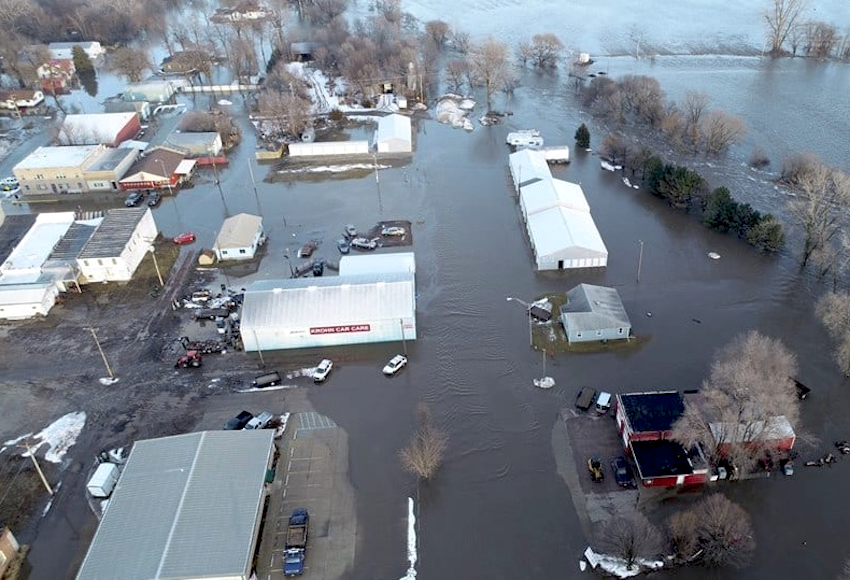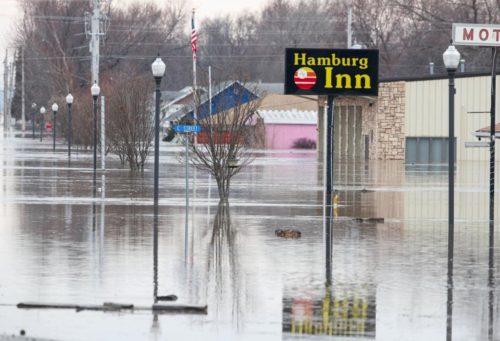
The Mississippi River has been at major flood stage for 41 days and counting, and this week a temporary wall failed, sending water rushing into several blocks of downtown Davenport, Iowa.
In that same area — the Quad Cities area of Iowa and Illinois — the river crested at a new record height. The National Weather Service says a new record appears to have been set at Rock Island, Ill.
The previous area record was set during the Great Flood of 1993 — and as NPR’s Rebecca Hersher has reported, that flood caused some $15 billion in damage.
Davenport Mayor Frank Klipsch says the city had placed temporary barriers to protect against rising water, and a small section of those barriers eventually was breached on Tuesday after holding for weeks.
The damage and deaths (now numbering 4) in the wake of these floods have drawn comparisons to those experienced in 1993.
Looking at the developments, one long-term analyst of the flood plains questioned if environmental policies contributed to this disaster.
Joe Herring, a contributor to American Thinker, took a look at data relayed to the catastrophic flooding of the Missouri River basin in 2011.
He noted that priorities of the Corps of Engineers, as expressed in its manual related to flood control policies for that region, placed “habitat restoration” ahead of human life and property.
From the completion of the dam construction (in 1967) until 2004, the Master Water Control Manual listed the priority functions in order of importance, with flood control being number one.
1) flood control
2) irrigation and upstream beneficial uses
3) downstream water supply
4) navigation and power
5) recreation and wildlifeIn 2004, under pressure from environmentalist organizations who had been lobbying hard for the previous decade, Congress approved a revision to the manual that no longer specifically prioritized the uses of the system, leaving the order of the functions to the discretion of the Corps of Engineers.
The previous list was then essentially upended, with wildlife (habitat restoration, preservation, and imitation of natural cycles) becoming the top priority, and all the others swapping places back and forth depending on the year.
Hamburg, Iowa, a small town southeast of Omaha, Nebraska, experienced terrible flooding in 2011 and raised the heights of their levees.
The Corps of Engineers, based on the new green justice values, forced a height reduction of those structures.
Hamburg now sits underwater.
“We want our future — with our businesses back and our people home,” Cathy Crain, who has been the mayor of Hamburg, Iowa, for 12 years, tells Here & Now’s Robin Young.
Crain says two-thirds of Hamburg was underwater when the bomb cyclone hit in March, causing flood waters to overflow the levee that protects the town from the Missouri River. Half the town is still submerged from the flooding, she says.
If you thought California has crazy water policies protecting baitfish, then behold the Corps of Engineers’ projects “reconnecting the rivers to floodplains” on behalf birds!
The importance of this concept to the overall goal of “river recovery” can be readily seen in the anthropomorphic spall that surrounds its use, as if the river is a mother cruelly separated from her child, the floodplain, by the heartless brutality of man.
What does “reconnecting the river to its floodplain” mean? Just ask the plaintiffs who recently won a 375-million-dollar judgment against the Corps for causing repeated flooding and enhancing those floods’ severity. The phrase is a euphemism for letting the river flood despite decades of efforts to prevent just that.
Since 2004, the Corps has been notching levees and dikes and re-opening old river chutes, destabilizing the once-shored riverbanks and encouraging shallowing and widening to facilitate the construction of “emergent sandbar habitat” — believed to be beneficial to the endangered Least Tern and Piping Plover bird species and the Pallid Sturgeon, a dinosaur of a fish that somehow managed to survive for millennia without the Corps’s assistance.
We are about to be flooded with assertions that this disaster is the result of climate change. That is partly true…as there was a change in the political climate placing the needs of the birds and fish ahead of the needs of American families.
Read more at Legal Insurrection


















Global warming alarmists predicted that the Great Lakes water levels would drop, due to drought, heat and lack of winter ice coverage. Instead, this year’s forecast says Lake Superior and Lake Erie will set new records for high water levels. Some “experts” on atmospheric CO2 got it wrong, big time.
Environmentalist organizations have clearly made forest fires worse. Now they may have done with flooding. It is amazing how much damage these organizations have done.
Climate prophets are getting a smack down from God. Man does not control the weather.
The IPCC called for heat and drought, they’re getting a lesson in humility instead.